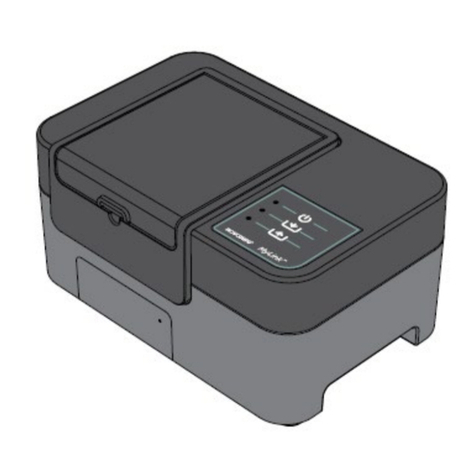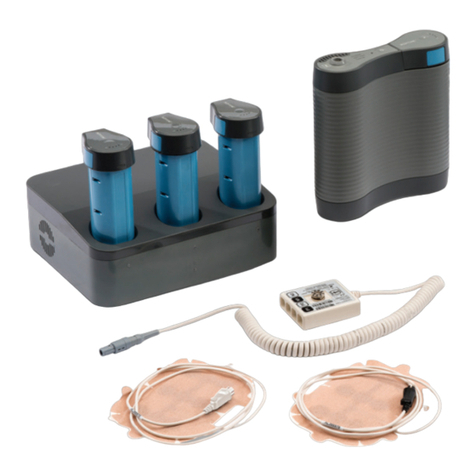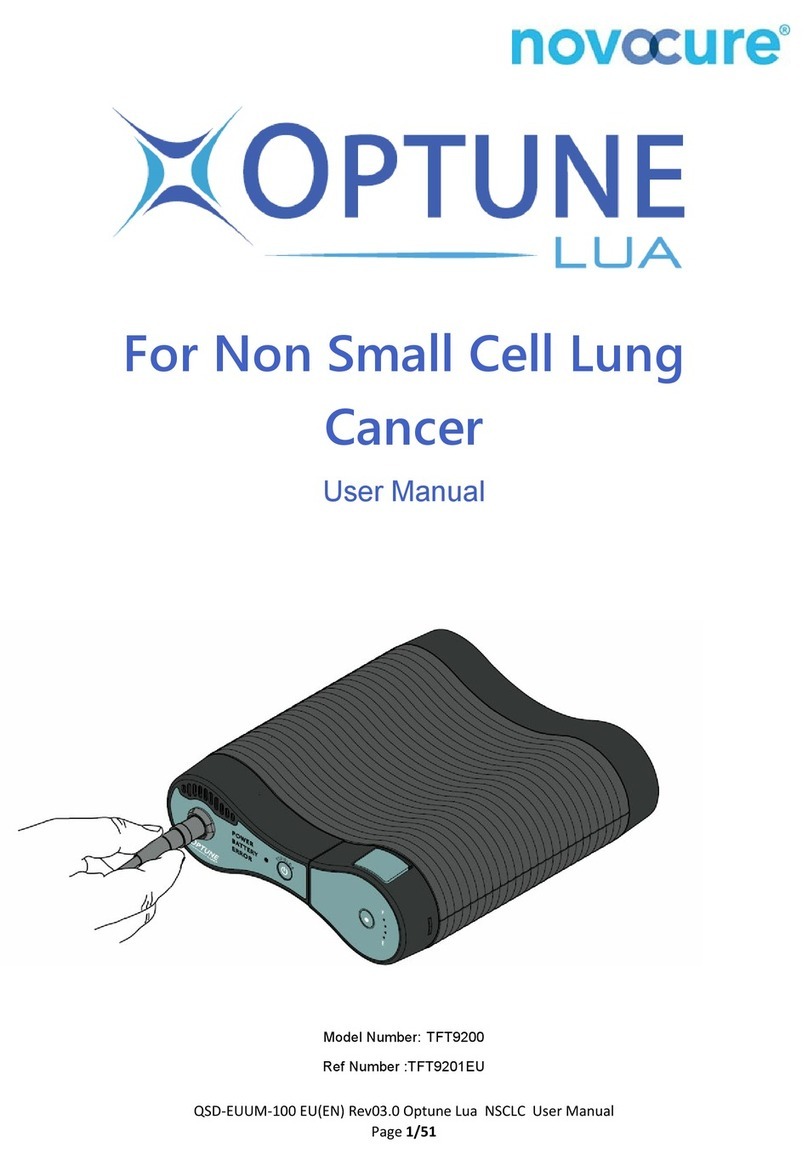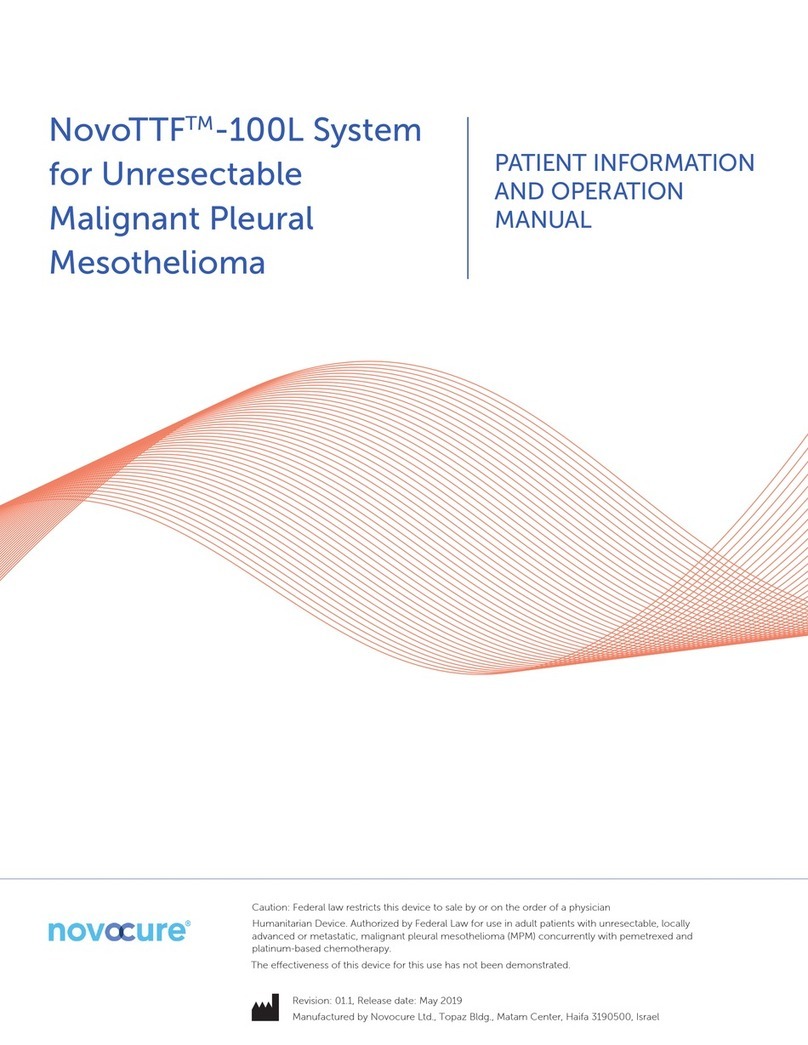novocure Optune NovoTTF 200A User manual

USER MANUAL

Document number QSD-EUUM-001-EN
Revision 04
Release date: July 12, 2016

3
TABLE OF CONTENTS
1
About Optune®Treatment Kit................................................................. 5
2
Indications for Use ............................................................................... 6
3
Contraindications, Warnings & Precautions ............................................... 7
4
What are the Risks of Treatment with Optune Treatment Kit? .....................11
5
Overview of Optune Treatment Kit .........................................................12
6
The Device .........................................................................................13
7
Starting & Stopping the Device ..............................................................14
8
Connecting & Disconnecting the Battery..................................................18
9
Charging the Battery ...........................................................................22
10
Using the Power Supply........................................................................24
11
The Connection Cable & Box .................................................................26
12
Carrying the Device .............................................................................29
13
Glossary of Graphic Symbols.................................................................30
14
Environmental Conditions for Normal Operation, Storage and Transportation 32
15
Troubleshooting ..................................................................................34
16
Assistance & Information......................................................................38
17
Appendix A –Information for Physicians .................................................39
18
Appendix B –Applicable Standards ........................................................40
19
Appendix C –Input Output Specifications................................................41
20 Appendix D –Emitted Radiation & Electromagnetic Compatibility ................42
21
Appendix E –Glossary .........................................................................49
22
Appendix F –Expected Service Life ........................................................50
23
Appendix G –Safety and Effectiveness Results –newly diagnosed GBM .......51
24
Appendix H –Safety and Effectiveness Results –recurrent GBM .................56

4
This manual is intended for both physicians prescribing the use of Optune®Treatment Kit
and INE Transducer arrays (Sterile), and for patients receiving TTField treatment using
this device.

5
1
About Optune®Treatment Kit
Optune Treatment Kit (NovoTTF-200A) is intended for the treatment of patients with
recurrent GBM and for the treatment of patients with newly diagnosed GBM (together with
maintenance Temozolomide).
Optune Treatment Kit a portable medical device. It delivers electric fields called “TTFields”
to the tumor in the brain using INE Transducer arrays. TTFields are intended to kill cancer
cells. The TTFields are transmitted at a frequency of 200 KHz and up to 707mA RMS
output current.
Your doctor has prescribed Optune Treatment Kit for use at home. You may be able to use
Optune Treatment Kit on your own, or you may need help from a doctor, family member,
or other caregiver. Use Optune Treatment Kit as many hours per day as possible, at least
18 hours per day. Only take short breaks for personal needs.
Optune Treatment Kit is portable and has the ability to run on batteries. You can continue
your normal daily life while carrying the device in a shoulder bag or backpack. The
Treatment Kit includes four rechargeable batteries. Each battery will last for up to two or
three hours. For sleeping, or other times when you plan to stay in the same place for a
while, plug the device power supply into a standard wall outlet.
Optune does not need regular maintenance. The Optune Treatment Kit also does not have
any settings for you to change.
The only things you need to do are check that the device has a power source connected (a
charged battery plugged into the device, or is connected to a power supply plugged into
the wall) and turn it on and off. If the device is not working, an audible error indicator will
beep.
A simple Troubleshooting Guide is provided in this manual (Section 15). You can also call
the 24-hour technical support telephone number (Section 16).
Shave your scalp and change the INE Transducer arrays twice a week. Keep periods of
time off from treatment to a minimum.
Interrupt treatment only for personal needs such as bathing, exercise, or any time where
the device may be a distraction. Stop treatment to replace the INE Transducer arrays.
To take a shower, unplug the INE Transducer arrays from the device (leave the INE
Transducer arrays on your head) and put a shower cap on your head so they do not get
wet. You can take a full shower and wet your head when you are not wearing the INE
Transducer arrays (for example, when you have taken them off but before replacing them
with a new pair). You can wear a wig or hat over the INE Transducer arrays, if you wish.

6
2
Indications for Use
Optune Treatment Kit is intended for the treatment of patients with newly diagnosed GBM
and for the treatment of patients with recurrent GBM.
Newly diagnosed GBM
NovoTTF-200A (OptuneTM) Treatment Kit is intended for the treatment of patients with
newly diagnosed GBM, after surgery and radiotherapy with adjuvant Temozolomide,
concomitant to maintenance Temozolomide. The treatment is intended for adult patients,
18 years of age or older, and should be started more than 4 weeks after surgery and
radiation therapy with adjuvant Temozolomide. Treatment may be given together with
maintenance Temozolomide (according to the prescribing information in the Temodar
package insert) and after maintenance Temozolomide is stopped.
Recurrent GBM
NovoTTF-200A (OptuneTM) Treatment Kit is intended for the treatment of patients with
recurrent GBM who have progressed after surgery, radiotherapy and Temozolomide
treatment for their primary disease. The treatment is intended for adult patients, 18 years
of age or older, and should be started more than 4 weeks after the latest surgery,
radiation therapy or chemotherapy.

7
3
Contraindications, Warnings & Precautions
CONTRAINDICATIONS
Do not use Optune Treatment Kit if you are pregnant, think you might be pregnant, or
are trying to get pregnant. If you are a woman who is able to get pregnant, you must use
birth control when using the device. Optune Treatment Kit was not tested in pregnant
women.
Do not use Optune Treatment Kit if you have significant additional neurological disease
(primary seizure disorder, dementia, Progressive degenerative neurological disorder,
Meningitis or encephalitis, Hydrocephalus associated with increased intracranial pressure)
Do not use Optune Treatment Kit if you are known to be sensitive to conductive
hydrogels like the gel used on electrocardiogram (ECG) stickers or transcutaneous
electrical nerve stimulation (TENS) electrodes. In this case, skin contact with the gel used
with Optune Treatment Kit may commonly cause increased redness and itching, and
rarely may even lead to severe allergic reactions such as shock and respiratory failure.
Do not use Optune if you have an active implanted medical device, a skull defect (such
as, missing bone with no replacement) or bullet fragments. Examples of active electronic
devices include deep brain stimulators, spinal cord stimulators, vagus nerve stimulators,
pacemakers and defibrillators. Use of Optune together with implanted electronic devices
has not been tested and may lead to malfunctioning of the implanted device. Use of
Optune together with skull defects or bullet fragments has not been tested and may
possibly lead to tissue damage or render Optune ineffective.

8
WARNINGS
Warning - Use Optune Treatment Kit only after receiving training from qualified
personnel, such as your doctor, a nurse, other medical personnel, or Novocure Device
Support Specialist who have completed a training course given by the device
manufacturer (Novocure). Your training will include a detailed review of this manual and
practice in the use of the system. In addition, you will be trained in what to do if there
are problems with treatment. Use of Optune Treatment Kit without receiving this training
can result in breaks in treatment and may rarely cause increased scalp rash, open sores
on your head, allergic reactions or even an electric shock.
Warning - Do not use Optune Treatment Kit if you are 18 years old or younger. It is
unknown what side effects the device may cause in these cases or if it will be effective.
Warning - In case of skin irritation, which appears as redness under the INE Transducer
arrays (a mild rash), use high potency topical steroids when replacing INE Transducer
arrays. This will help relieve your skin irritation. If you do not use this cream, the skin
irritation can become more serious and may even lead to skin break down, infections,
pain and blisters. If this happens, stop using the topical steroid cream and contact your
doctor. Your doctor will supply you with an antibiotic cream to use when replacing INE
Transducer arrays. If you do not use this cream, your symptoms may continue and your
doctor may ask you to take a break from treatment until your skin heals. Taking a break
from treatment may lower your chance to respond to treatment.
Warning - All servicing procedures must be performed by qualified and trained personnel.
If you attempt to open and service the system alone you may cause damage to the
system. You could also get an electric shock by touching the inner parts of the device.
Warning - No modification of this equipment is allowed.

9
PRECAUTIONS
Caution - Keep the Optune Treatment Kit out of the reach of children and pets.
Caution - Do not use any parts that do not come with the Optune Treatment Kit or that
were not sent to you by the device manufacturer or given to you by your doctor.
Caution - Do not use the Optune Treatment Kit if any parts look damaged (torn wires,
loose connectors, loose sockets, cracks or breaks in the plastic case).
Caution - Do not wet the device or INE Transducer arrays. Getting the device wet may
damage it, preventing you from receiving treatment for the right amount of time. Getting
the INE Transducer arrays very wet is likely to cause the INE Transducer arrays to come
loose from your head. If this happens, the device will operate the notification signal and
you will need to change the INE Transducer arrays.
Caution - Before connecting or disconnecting the INE Transducer arrays, make sure that
the Optune power switch is in the OFF position. Disconnecting INE Transducer arrays
when the device is running will cause a device notification signal to go off, and could
damage the device.
Caution - Connection Cable may pose a hazard of strangulation. Avoid wearing the
connection cable around your neck.

10
NOTICES
Notice! Optune Treatment Kit and INE Transducer arrays will activate metal detectors.
Notice! You should use the Optune Treatment Kit for at least 18 hours a day to get the
best response to treatment. Using Optune Treatment Kit for less than 18 hours a day
lowers the chances that you will respond to treatment.
Notice! Do not stop using the Optune Treatment Kit even if you have used it less than
the recommended 18 hours per day. You should stop using the device only if your doctor
tells you to. Stopping treatment could lower the chances that you will respond to
treatment.
Notice! If you plan to be away from home for more than 2 hours, carry an extra battery
and/or the power supply with you in case the battery you are using runs out. If you do
not take a spare battery and/or the power supply you may have a break in your
treatment. Breaks in treatment may lower your chance to respond to treatment.
Notice! Batteries may weaken over time and need to be replaced. You will know this has
happened when the amount of time the device can run on a fully charged battery begins
to shorten. For example, if the low battery indicator lights up within only 1.5 hours from
the start of treatment, replace the battery. If you do not have replacement batteries
when your batteries run out, you may have a break in your treatment. Breaks in
treatment may lower your chance to respond to treatment.
Notice! Do not block the device vents located on the front and bottom of the Optune
device. Blocking the vents may cause the device to overheat and operate the notification
signal, leading to a break in treatment. If this happens, unblock the vents, wait 5
minutes and restart the device.
Notice! Do not block the battery charger vents located on the sides of the battery
chargers. Blocking the vents may cause the charger to overheat. This could prevent your
batteries from charging.

11
4
What are the Risks of Treatment with Optune
Treatment Kit?
Skin irritation is often seen under the INE Transducer arrays when using the Optune
Treatment Kit. This will look like a red rash, small sores or blisters on your scalp. In
general, Optune will not cause skin damage that cannot be fixed. The irritation can be
treated with topical steroid cream or by moving the INE Transducer arrays. If you do not
use the topical steroid cream, the skin irritation could become more serious. This may
lead to open sores, infections, pain and blisters. If this happens, stop using the steroid
cream and contact your doctor.
Number of Patients with Adverse Events by Body System table in Appendix H shows the
occurrence of medical problems in recurrent glioblastoma patients using the Optune
Treatment Kit alone compared to patients using cancer drugs.
Adverse Events by Body System and Severity table in Appendix G shows the occurrence of
medical problems in newly diagnosed glioblastoma patients using the Optune Treatment
Kit together with cancer drugs compared to patients using cancer drugs alone.

12
5
Overview of Optune Treatment Kit
1
Plug in power supply (Model SPS9100)
2
Charger for batteries (Model ICH9100)
3
Insulated Transducer array (INE) –(Model INE9000)
4
Device & battery carrying bag (Model BAG9100)
5
Optune electric field generator (the Device) (Model TFH9100)
6
Battery (Model IBH9100)
7
Connection cable & box (Model CAD9100)

13
6
The Device
The Optune Treatment Kit treatment parameters are preset and cannot be changed by the
patient. TTField treatment should be kept on as continuously as possible (24 hours a day,
7 days a week). Although 100% treatment time is impossible, breaks from treatment
should be kept as short as possible.
You will need to learn how to place it in a carrying bag, connect a battery and operate the
system.
The following controls will allow you to operate the Optune device:
1 Optune power button 2 Power Supply Connection cable socket 3 TTField therapy ON/OFF button
4 Power ON/ Error / Low Battery indicator 5 Connection Cable (CAD) socket 6 Battery Gauge
Note: Instruction on how to use INE Transducer arrays can be found in the INE Transducer
array User Manual supplied with the INE Transducer arrays.

14
7
Starting & Stopping the Device
To start treatment, connect a power source - either a charged battery or a power
supply (see Section 8 or 10) to the device.
1.
Turn the power button on the bottom of the device to the on position
2.
Wait approximately 10 seconds for the self-check to be completed. The "Power"
indicator on the front of the device will light up green.
If a charged battery is installed and there is no power supply plugged in, the "Battery"
indicator will also light up green.
If a power supply, connected to the mains, is plugged into the device, the device will run
off of the power supply and the "Battery" indicator will not illuminate.
Press the TTField therapy ON/OFF button once –this will start treatment.

15
The blue indicators surrounding the TTFields therapy ON/OFF button will light up and
remain on for as long as treatment continues.
Note: The green, blue and yellow indicators will dim in a dark room and will brighten in a
light environment. The red error indicator light will not be dimmed in any case.
If the therapy button is not pressed within several minutes after the device is
turned ON, a notification signal will sound, indicating that the device is ON but
the therapy is OFF. This is a reminder to start the therapy. The therapy button
should be pressed once to silence the notification signal and again to start the
therapy.
Stopping treatment may be performed in each of the following situations:
a)
When the device is running properly:
Press the TTFields button –The blue indicator surrounding the TTField therapy ON/OFF
button will turn off.

16
Then, turn off the device by turning the power button on the bottom of the device to the
off position.
b)
If an Error Occurs:
If an error occurs, the device will turn off the TTFields and make a loud beeping noise.
The red Error light will light up (as shown below).
To turn off the device:
1.
Press the TTFields button on the front of the device to stop the notification signal.
The red Error light will turn off.
2.
Turn off the device by turning the power button to the off position.
3.
See the Troubleshooting Guide (Section 15) for instructions on fixing problems.
Restart the device and restart treatment if no problem is found. If the notification
signal does not stop, contact technical support (Section 16).
c)
When the Low Battery indicator lights up:
When the battery has about 20 % power left the “Battery” indicator will turn yellow,
alerting you that you will need to change battery soon.

17
When your battery runs out (after about 2–3 hours), the notification signal will beep, and
the TTFields therapy will stop. When this happens the "Battery" indicator will turn yellow
and red Error light will light up. This notification signal sound is the same sound the device
makes for an error. However, in this case both the yellow "Battery" and red "Error"
indicators will light up instead of just the red light.
To turn off the device:
1.
Press the TTFields button on the front of the device to stop the notification signal.
The red Error and the yellow Battery lights will turn off.
2.
Turn off the device using the on/off switch.
3.
Replace the battery using the steps in Section 8.

18
8
Connecting & Disconnecting the Battery
The Optune Treatment Kit comes with 4 rechargeable batteries. Batteries slide into the
device, while the blue buttons on both sides of the battery are being held. The battery
should be inserted until there is a “click”, indicating the battery is in place. Take care not to
drop the battery in place or to force it into the battery slot. Optune uses one (1) battery at
a time. The other three (3) batteries should stay in the battery charger. Each battery lasts
2 to 3 hours. Replace the battery each time it runs out (when the yellow Low Battery
indicator light is on, as described in Section 6). If you plan to be away from home for more
than 2 hours, carry extra batteries or a power supply.
Gently press down to lock the battery in place. Make sure the battery latch is fully
engaged.
To remove the battery from the slot, Press both blue buttons on the side of the battery and
slide up until removed.

19
Recharge the batteries in the charger (see Section 9) for four to five hours. The batteries
will stay charged if they are off the charger for a short time (hours, but not days). For
this reason, keep the extra batteries in the charger at all times, if possible. You can
charge and use the batteries many times. Over nine to twelve months, the length of time
the batteries can run the device (before the low battery notification signal beeps) will get
shorter. When this happens, contact technical support (see Section 16) to get
replacement batteries.
When the yellow Low Battery indicator light lights up, there are two ways you can
replace the depleted battery with a charged battery.
Option One: (to be used if near the direct wall power supply) allows you to change the
battery without interrupting therapy. This can be used before the battery is completely
depleted, and before the device has operated the notification signal. Please follow these
steps:
Plug the power supply cord into bottom of the Optune device. (See Section 10)
The lights on the display panel will indicate you are no longer running on battery power.
Remove the battery from the battery slot by pressing on the blue buttons on the side of
the battery.
Slide the fully charged battery in the battery slot, gently push down to lock in place.
Remove the power supply cord from the bottom of the device.

20
Option Two: If you are not near the power supply, or if the battery has totally depleted
please replace the battery using these steps:
Turn off the notification signal by pressing the TTFields button once.
Turn off the device using the power button (on the bottom of the device).
Remove the battery from the battery slot by pressing on the blue buttons on the side of
the battery.
Slide the fully charged battery in the battery slot, gently push down to lock in place.
Turn on the device and start treatment by turning the power button on, wait for the
system to run a self-check (this takes about 10 seconds) then press the TTFields button
(see Section 6).
Place the used battery in the charger for recharging (as described in Section 9).
Checking the Battery Gauge
While you are using Optune, you may want to check how much power is left in your
battery. Checking the battery will not interfere with or stop your treatment.
To check the battery power press the button on the top of the battery cartridge once.
The remaining battery power will be indicated by the readout to the right of the button.
The gauge reads from full to empty, like a gas gauge in your car.
Other manuals for Optune NovoTTF 200A
1
Table of contents
Other novocure Medical Equipment manuals
Popular Medical Equipment manuals by other brands

Getinge
Getinge Arjohuntleigh Nimbus 3 Professional Instructions for use

Mettler Electronics
Mettler Electronics Sonicator 730 Maintenance manual

Pressalit Care
Pressalit Care R1100 Mounting instruction

Denas MS
Denas MS DENAS-T operating manual

bort medical
bort medical ActiveColor quick guide

AccuVein
AccuVein AV400 user manual
















